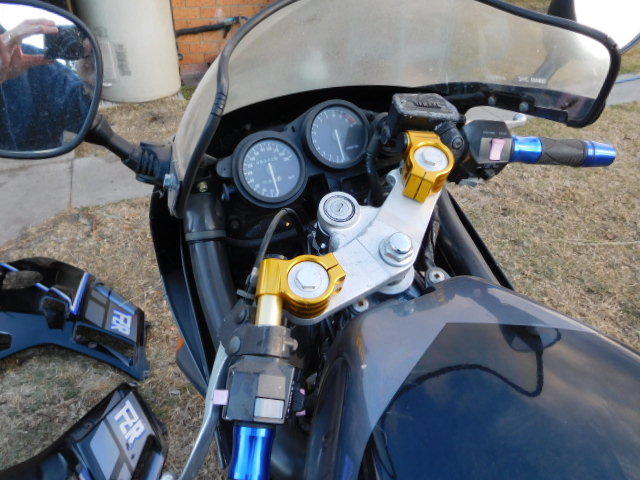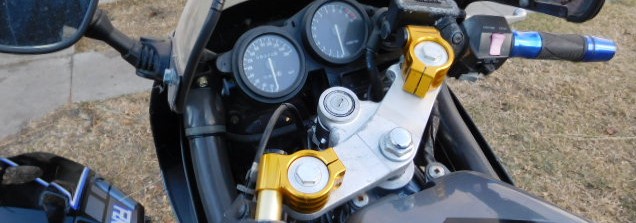Yes, I’m getting into semantics here, but although Project FZR was now, in the eyes of The Man, considered roadworthy, it wasn’t really in a state where it was in any way worthy of taking on the road.
BIKE IS UNSAFE TO RIDE AS IT IS
This phrase, as the author no doubt hoped it would, started flashing in neon signs in my head every time I jumped on the bike to take it for a quick blockie, to work or down to the shops. That said, I also wasn’t prepared at that point to accept that slotting in a second-hand motor was the only sensible way to go about it, and it turns out I was right.
But first, why was this such a problem in the first place?
You may remember from my earlier post that the front sprocket (like a front chainring on a pushbike, except moving a whole lot faster) had been affixed to the output shaft from the motor using what is colloquially known as bodge. It was most likely some hard epoxy resin of some sort that had been put in a lump over the retaining nut that stops the sprocket from coming off at a few thousand RPM and embedding itself in some part of the bike, or perhaps the rider’s left leg.
Why on Earth was it on there in the first place?
Common sentiment from the Facebook forums I mentioned in the earlier post was that the most likely cause was someone over-tightening the retaining nut (more than likely with an impact wrench), stripping the thread, and upon realising their crime determined that a bodge job was the best alternative.
For reasons that I’ll write about later, I do see their point.
The shaft that the sprocket sits on is called the output shaft, and it sits right at the bottom of the motor, and holds gears that make up the transmission. To replace it, putting aside the few hundred dollars required to source a new one, entails removing the motor and stripping it from the top down, which in a best case scenario would mean perhaps a couple of hundred dollars more in new gaskets (assuming nothing else needed replacing) as well as perhaps ten or fifteen hours labour from a skilled mechanic (maybe less, maybe more, but around that I reckon). Add that up and it would comfortably be a couple of grand, perhaps upward of three or four, all to replace one stupid shaft.
But surely there had to be a better way…
This is where I was lucky enough to discover a newly opened business in Adelaide – The Motorcycle Society.
While the service I had received from the first place who got the bike roadworthy had been ok, it struck me that ‘swap your engine’ wasn’t exactly the most lateral thinking response to the problem. What I needed was somewhere which did more creative work, ideally on older bikes, and who could come up with something better than ‘swap your engine’.
Looking at the work they did, it was clear that they were probably more focused on creating custom bikes and restoring or modifying older bikes than mine. The late eighties and early nineties saw a leap in the technology used in bikes and the general style of them, and a lot of the cafe racer or bobber style conversion candidates that TMC seemed to focus on were more like ten years earlier than mine, but they seemed to be a better bet than most others I could find online, so I gave them a go.
A chat with the owner made it clear that there would very probably be other ways and means of re-affixing the sprocket nut without having to remove the motor and swap the shaft, and that was enough for me to hand it over to them to have a look.
While it was there it also seemed to make good sense to get it looked over to see what else needed to be done, particularly since it had been sitting for so long. This included giving the carbies a total clean out, loosening up the rear brake calipers which had rusted stuck (which at least explained why there wasn’t much in the way of back brakes on the thing), and replacing the clip-ons (a.k.a. the handlebars).

I’ve not mentioned the clip-ons as yet, but at some point, someone decided to throw out the originals and add some ‘bling’, in the form of some eBay special blue ones, held on by eBay special gold-coloured clamps. Needless to say, for a restoration project this look did not fit with the aesthetic I was after, so they had to go. I had managed to pick up a set of original clamps from the Victorian Parts Bike, but that still left me without the clip-ons themselves. After quite a while hunting eBay, Gumtree and various forums, I was stumped. Nobody had any for sale that were easily accessible, and I didn’t want to go down the path of more eBay cheap knockoffs.
Once again, enter The Motorcycle Society.
Their suggestion? Have some custom ones created by machining a couple of chunks of aluminium, since the owner ‘knew a guy’ who had access to the right materials and equipment to do it. Bloody brilliant.
But back to the main character in this chapter – the bodged sprocket.
After having another chat with the owner who said they had removed the old retaining nut and the lump of bodge (‘just tapped it with a hammer and the whole thing fell off’), they had managed to drill a thread into the end of the shaft, and then put a screw/spacer/washer setup on the end to keep everything in place. As the forums had said, there will be other ways and means instead of swapping out the motor – it just needed the right skills and a bit of creativity.
When I got the bike back it ran far better, didn’t look like a teenager’s iPad cover in the hand-controls area, it was no longer a death trap, and it even had back brakes.
But there were still some issues. A final chat with the owner noted the rattly timing chain and the looseness in the gearbox area, and the message was pretty clear – this engine was up and running, but it was probably not all that long for this world. We talked about the next phase of the project – getting the plastics and frame tidied up, and thinking about the motor at some stage in the future, and this opened up my mind proper to the ‘how long is a piece of string’ nature of bike restorations, which I’ll talk about in a later post…
Before I do though, I really must thank Gerard at the team at The Motorcycle Society. The FZR must have looked like a nightmare just waiting to happen when it rolled in, which it pretty much was, but the way that they’ve helped me either by fixing things that I couldn’t fix or by talking through options when I really needed another opinion has been brilliant, and I can’t think them enough. They also make excellent coffee and food, so if you’re in the Adelaide CBD then drop in for a look and a chat.
Next up: Stop everything! Again! (a.k.a. the Victorian spare motor)
